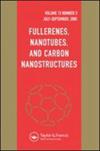Facile synthesis of high-density and vertically aligned carbon nanotube arrays on an acid treated stainless steel mesh
IF 1.8
4区 材料科学
Q3 CHEMISTRY, PHYSICAL
Fullerenes, Nanotubes and Carbon Nanostructures
Pub Date : 2023-10-22
DOI:10.1080/1536383x.2023.2270591
引用次数: 0
Abstract
AbstractDirectly growing vertically aligned carbon nanotube arrays (VACNTs) on conductive substrates has shown great potential in a wide variety of applications. Among the various substrates, stainless steel (SS) possesses the advantageous features of wide availability, diverse compositions, and Fe containing, all of which are favorable for direct use as a low-cost and efficient catalytic substrate for VACNT growth. However, it is still unachieved to grow high-density VACNTs on SS in a facile way due to the lack of effective engineering strategies on the SS surface. Herein, we demonstrate a facile but efficient method to grow dense and highly VACNTs on an SS mesh by simply etching the SS mesh with an optimized HCl solution. Experimental results show that the etching can remove the chromium-rich passive layer and create highly active sites for chemical vapor deposition. In addition, it is revealed that the presence of the high-melting element of Mo in SS 316 is essential for prolonging the lifetime of active sites. Compared to the case on the SS 304 without Mo element, the VACNTs grown on SS 316 exhibit a higher purity, better alignment, higher degree of graphitization, and more importantly, large height of 80 μm.Keywords: Carbon nanotubesaligned arraysstainless steeletchingchemical vapor deposition Disclosure statementNo potential conflict of interest was reported by the authors.Data availability statementThe authors confirm that the data supporting the findings of this study are available within the article and its supplementary materials.Additional informationFundingThis work was supported by National Key R&D Program of China (2022YFA1200075, 2018YFA0208404), National Natural Science Foundation of China (52172089), and Innovation Program of Shanghai Municipal Education Commission.酸处理不锈钢网上高密度垂直排列碳纳米管阵列的简易合成
摘要在导电衬底上直接生长垂直排列的碳纳米管阵列(VACNTs)具有广泛的应用前景。在各种底物中,不锈钢(SS)具有广泛可用性、成分多样、含铁等优势,这些都有利于直接作为低成本、高效的VACNT生长催化底物。然而,由于缺乏有效的SS表面工程策略,在SS表面上快速生长高密度vacnt仍未实现。在这里,我们展示了一种简单而有效的方法,通过简单地用优化的HCl溶液蚀刻SS网格,在SS网格上生长密度高的vacnt。实验结果表明,蚀刻可以去除富铬钝化层,形成化学气相沉积的高活性位点。结果表明,高熔点Mo元素的存在是延长活性位点寿命的重要因素。与未添加Mo元素的SS 304相比,在SS 316上生长的vacnt具有更高的纯度、更好的取向性、更高的石墨化程度,更重要的是,vacnt的高度可达80 μm。关键词:碳纳米管阵列;不锈钢蚀刻;化学气相沉积;数据可用性声明作者确认,支持本研究结果的数据可在文章及其补充材料中获得。基金资助:国家重点研发计划项目(2022YFA1200075, 2018YFA0208404)、国家自然科学基金项目(52172089)、上海市教委创新计划项目。
本文章由计算机程序翻译,如有差异,请以英文原文为准。
求助全文
约1分钟内获得全文
求助全文
来源期刊

Fullerenes, Nanotubes and Carbon Nanostructures
工程技术-材料科学:综合
CiteScore
4.80
自引率
17.40%
发文量
85
审稿时长
1 months
期刊介绍:
The international and interdisciplinary forum, Fullerenes, Nanotubes, and Carbon Nanostructures , aims at publishing peer-reviewed research of original work in all areas of CARBON research including fullerenes, nanotubes, nanodiamond, graphene, any type of carbon nanostructure and any work dealing with carbon and carbon-related topics. Publishing high quality papers from all fields of carbon science and related topics, the journal intends to provide a means of communication between researchers who are interested in fundamental and applied carbon science issues.
 求助内容:
求助内容: 应助结果提醒方式:
应助结果提醒方式:


